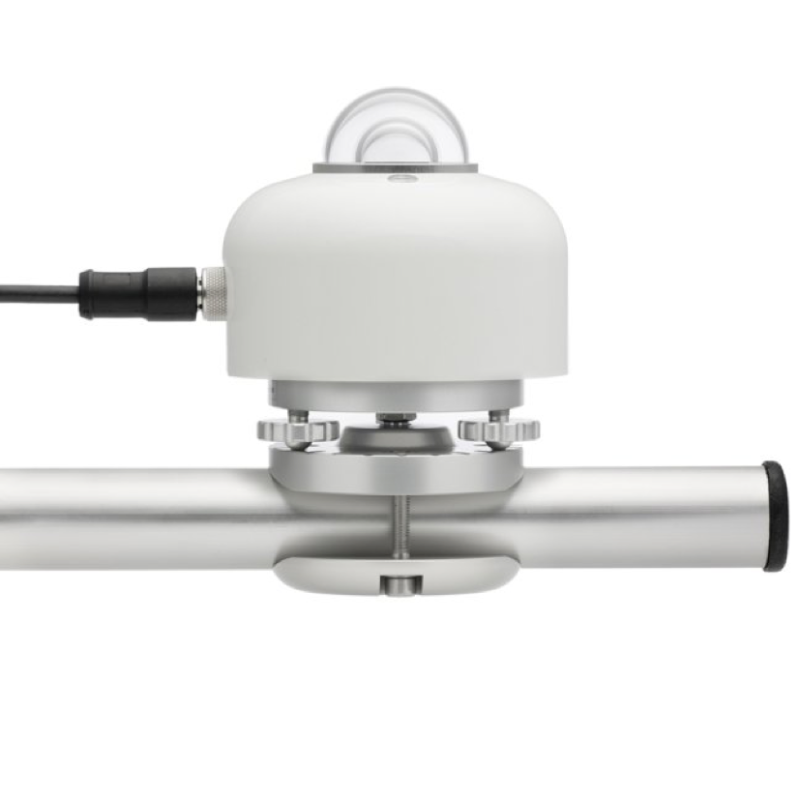
Reference: 10HS ECHO - 5Mts
Reference: 10HS ECHO - 5Mts
Reference: BASE-U-4
Reference: UA-002-64
Brand: ONSET
Reference: VH400-2M
Brand: VEGETRONIX
Reference: DS1922E-F5
Brand: iBUTTON MAXIM INTEGRATED





Analogue first class pyranometer with heater
SR15-A1 is a high-accuracy solar radiation sensor. It is "First Class" according to the ISO 9060:1990 standard and “Spectrally Flat Class B” in the 2018 revision. With its on-board heater, it is compliant in its standard configuration with the requirements for “Class B” PV monitoring systems of the new IEC 61724-1:2021 standard. SR15-A1 offers analogue millivolt output.
| Measurand | hemispherical solar radiation |
| ISO 9060:2018 classification | spectrally flat Class B pyranometer |
| ISO 9060:1990 classification | first class pyranometer |
| Application | National Meteorological Networks,PV monitoring commercial and utility scale,PV monitoring small sized,meteorology / climatology,other |
| Heater | yes |
| Output | mV |
| Calibration uncertainty | < 1.8 % (k = 2) |
| Calibration traceability | to WRR |
| Spectral range | 285 to 3000 x 10⁻⁹ m |
| Sensitivity (nominal) | 10 x 10⁻⁶ V/(W/m²) |
| Analogue output | millivolt |
| Response time | < 10 s |
| Zero offset a | 5 W/m² unventilated |
| Rated operating temperature range | 40 to +80 °C |
| Temperature response | < ± 2 % (-10 to +40 °C) |
| Heater | 1.5 W at 12 VDC |
| Standard cable length | 5 m |
| On-board heater | included |
| Levelling | optional spring-loaded levelling, with or without tube mount |
| Version order codes | SR15-A1, SR15-A1-LM01, SR15-A1-TLM01, SR15-A1-S7-8.5 |
Options
PV system performance monitoring – IEC Class B compliant
IEC 61724-1: Photovoltaic system performance monitoring – Guidelines for measurement, data exchange and analysis – requires heating for Class B monitoring. The SR15-A1, with its built-in heater, offers Class B compliance without the need for additional accessories.
Improved measurement accuracy
Calibration of the SR15-A1 pyranometer has been improved – our latest calibration method results in a sensitivity uncertainty of 1.8%, compared to typical uncertainties of over 2.8% for this class of pyranometer. The zero offset of the SR15-A1 is 5 W/m² without ventilation. The response time of the SR15-A1 is < 10 s, a significant improvement over previous sensors.
Suggested Use
Photovoltaic System Performance Monitoring
General Solar Resource Monitoring
Indoor Simulated Solar Testing
Weather Networks
How Does a Pyranometer Work?
A pyranometer measures the solar radiation received by a flat surface from a viewing angle of 180°. This quantity, expressed in W/m², is called “hemispherical” solar radiation. The solar radiation spectrum extends from approximately 285 to 3000 x 10⁻⁹ m. By definition, a pyranometer should cover that spectral range with as “flat” a spectral selectivity as possible.
In an irradiance measurement, by definition, the radiation response of the “beam” varies with the cosine of the angle of incidence; that is, it should have a full response when solar radiation hits the sensor perpendicularly (normal to the surface, sun at zenith, incidence angle 0°), a zero response when the sun is at the horizon (incidence angle 90°, zenith angle 90°) and a 50% full response at an incidence angle of 60°. A pyranometer should have a so-called “directional response” (in older documents the “cosine response” is referred to) that is as close as possible to the ideal cosine characteristic.
To achieve the proper directional and spectral characteristics, the main components of a pyranometer are:
• a thermal sensor with a black coating. It has a flat spectrum covering the range from 200 to 50000 x 10⁻⁹ m and has an almost perfect directional response. The coating absorbs all solar radiation and, at the time of absorption, converts it into heat. The heat flows through the sensor into the sensor body. The thermopile sensor generates a voltage output signal that is proportional to the solar irradiance.
• a glass dome. This dome limits the spectral range from 285 to 3000 x 10⁻⁹ m (cutting off the part above 3000 x 10⁻⁹ m), while preserving the field of view angle of 180°. Another function of the dome is to protect the thermopile sensor from the environment (convection, rain).
• a second (inner) glass dome: for first-class and second-class pyranometers, two domes are used, and not just one. This construction provides an additional "radiation shield", resulting in a better thermal balance between the sensor and the inner dome, compared to using a single dome. The effect of having a second dome is a strong reduction of instrument drifts.
• a heater: To reduce the effect of dew and frost deposition on the outer surface of the dome, most advanced pyranometers have a built-in heater. The heater is coupled to the sensor body. Heating a pyranometer can generate additional irradiance drift signals, therefore it is recommended to activate the heater only at night. The combination of a heater with external ventilation makes these heating drifts very low.
Your review appreciation cannot be sent
Report comment
Report sent
Your report cannot be sent
Write your review
Review sent
Your review cannot be sent
Reference: BHW-PRO
Brand: ONSET
Reference: U3832G
Brand: COMET
Reference: SR30-M2-D1
Brand: Hukseflux
Reference: NRC-200
Brand: Meatrol
Reference: TRC-24
Brand: Meatrol
Brand: COMET
Reference: BL 18
Brand: ECOMATIK
Reference: Quido Estación agrometeorológica
Reference: LS193
Brand: LINSHANG
Reference: 21120003
Brand: FUEL CELL
Reference: ZSC
Brand: METER GROUP
Reference: M2 T
Brand: tempmate
Reference: Y031L
Brand: HORIBA LAQUAtwin
Reference: H721LC
Brand: VERIS
Reference: RK300-04
Brand: RIKA SENSORS

Analogue first class pyranometer with heater
SR15-A1 is a high-accuracy solar radiation sensor. It is "First Class" according to the ISO 9060:1990 standard and “Spectrally Flat Class B” in the 2018 revision. With its on-board heater, it is compliant in its standard configuration with the requirements for “Class B” PV monitoring systems of the new IEC 61724-1:2021 standard. SR15-A1 offers analogue millivolt output.
check_circle
check_circle